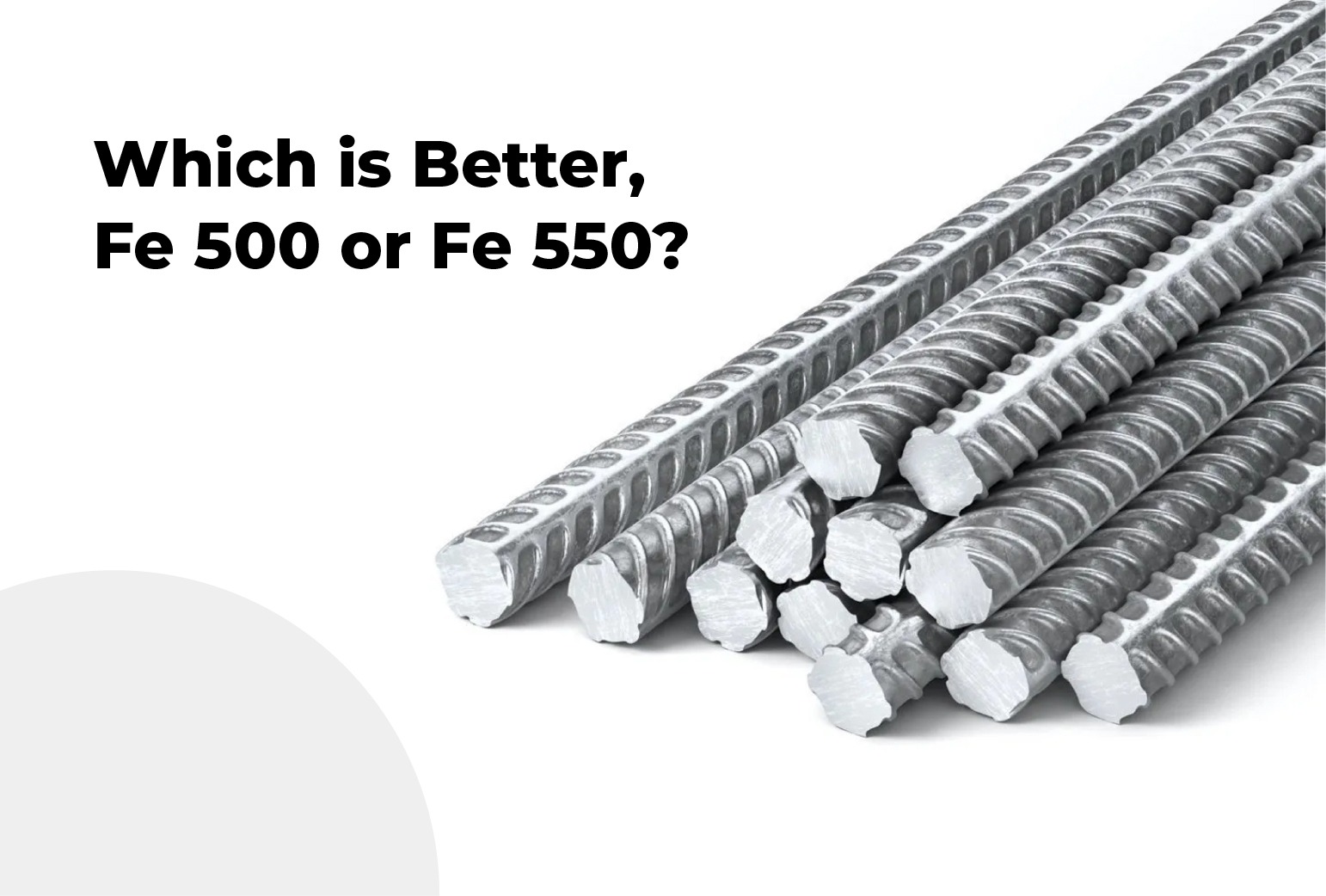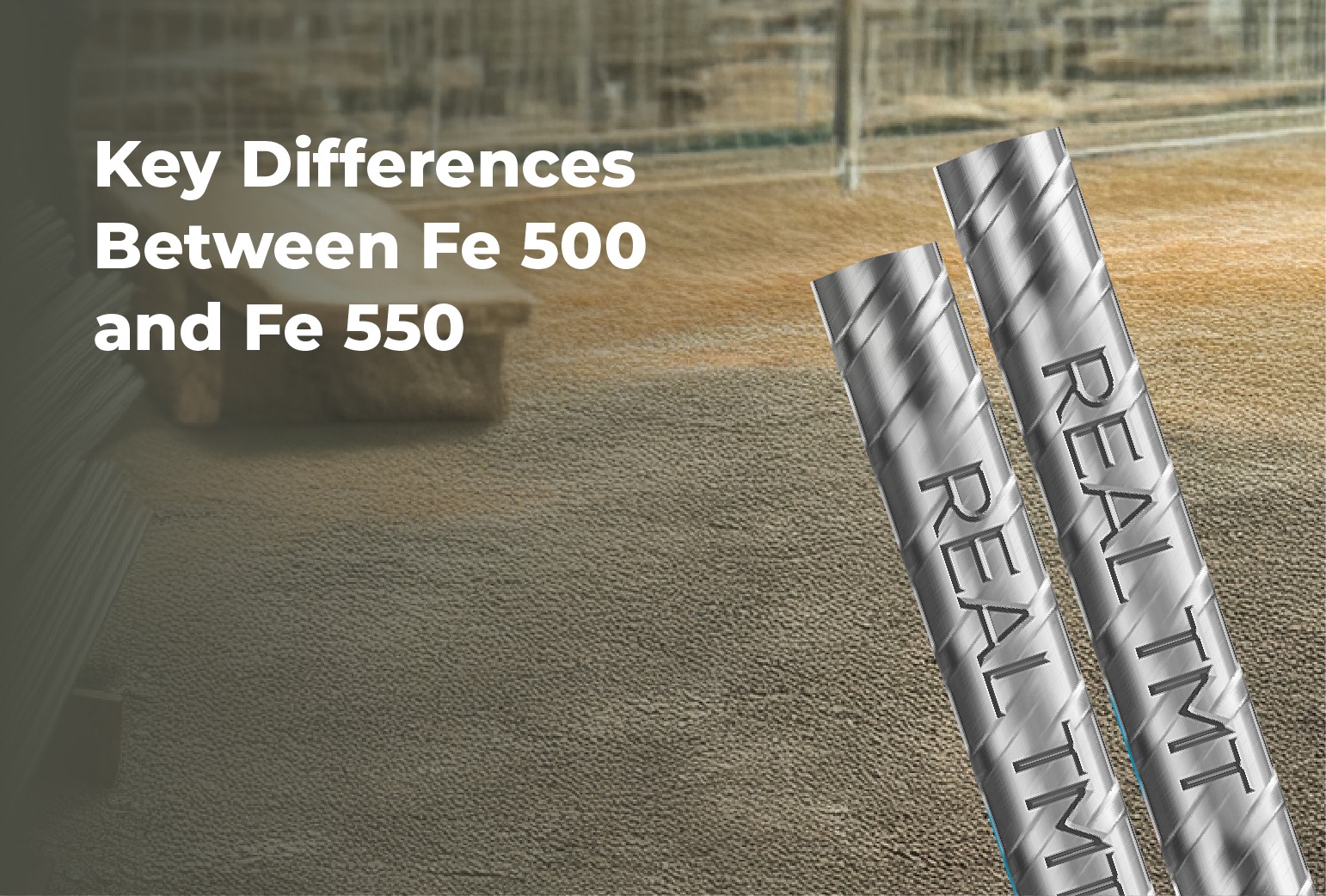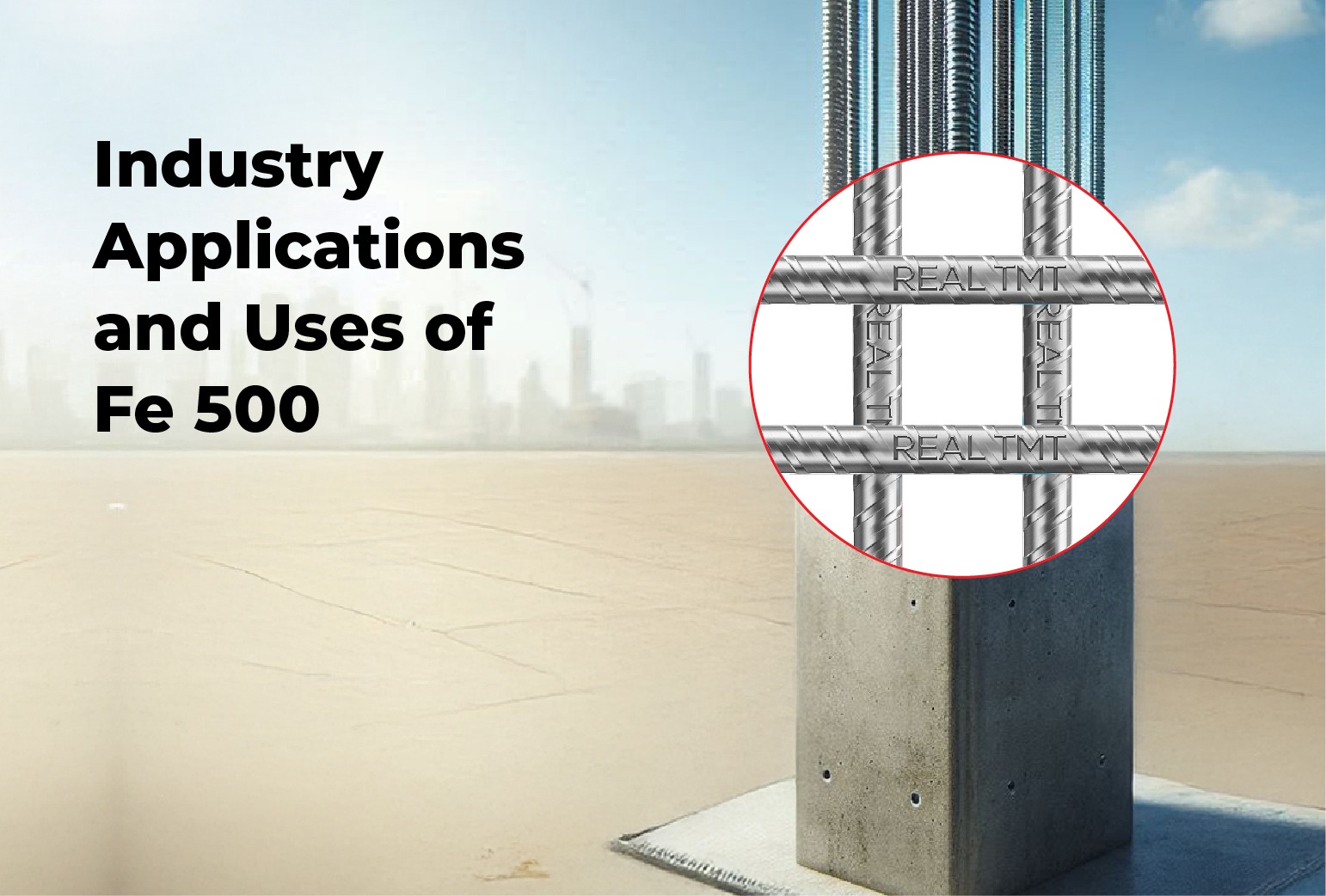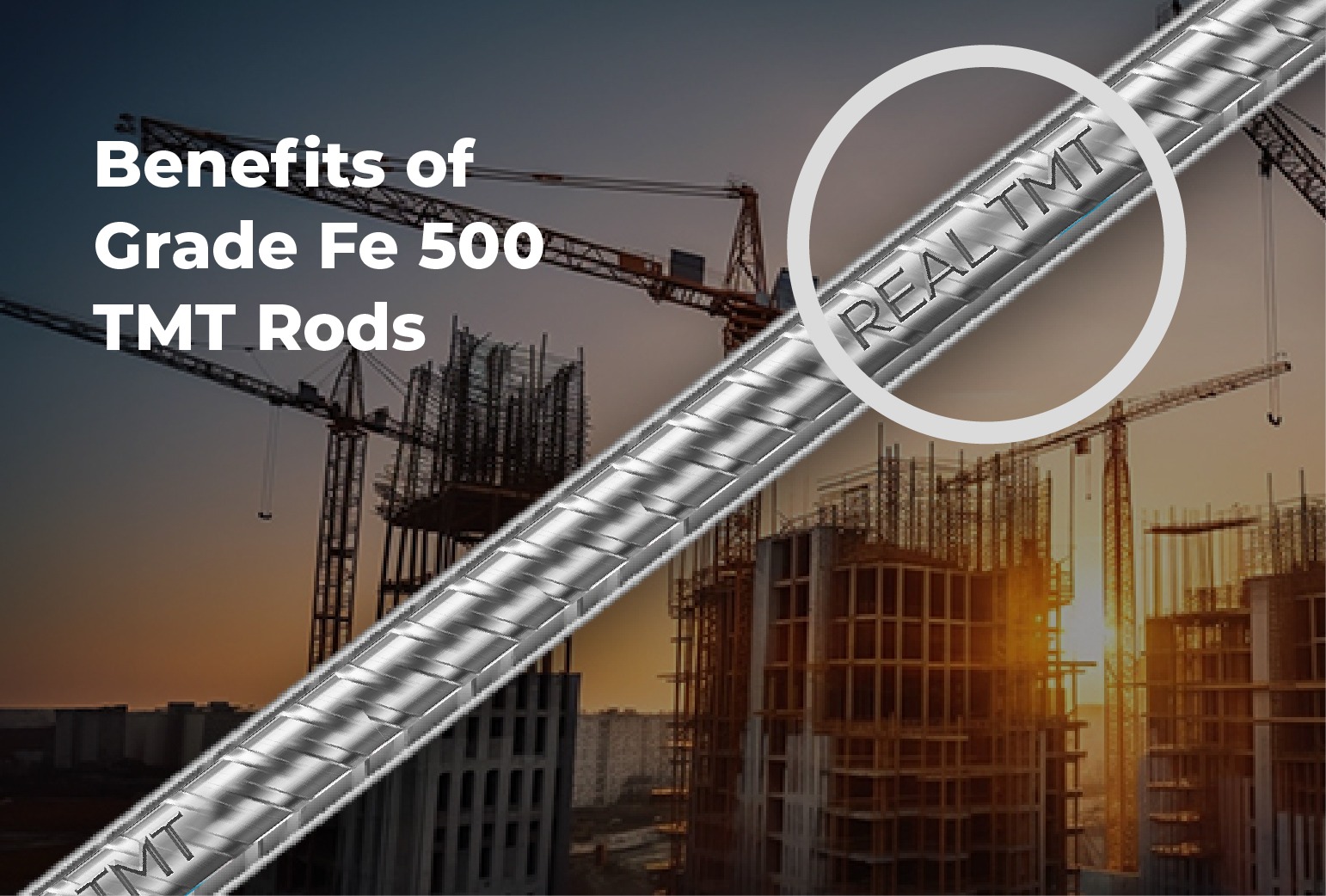Which is Better, Fe 500 or Fe 550?

In construction, every material choice impacts the structure’s performance, durability, and overall cost. Among the most critical decisions is selecting the right TMT iron rods grade. The two most commonly compared Fe grades in Nigeria are Fe 500 and Fe 550, both high-strength reinforcement bars used in modern construction. While they may appear similar, their mechanical properties, performance under stress, and practical applications differ significantly.
Fe 500 TMT bars offer an optimal balance between tensile strength and ductility. With a yield strength of 500 N/mm², they are strong enough to handle structural loads, yet flexible enough to absorb stress without breaking. This makes Fe 500 ideal for earthquake-prone zones, areas with fluctuating temperatures, and high-rise buildings where controlled flexibility is essential. Fe 550, on the other hand, has higher yield strength (550 N/mm²), but comes at the cost of reduced ductility. That reduction in flexibility can be a disadvantage in uses where seismic safety or structural shifts need to be absorbed without damage or cracking.
Another factor to consider is workability of the iron bars. Fe 500 TMT bars are easier to bend and weld, making them more versatile for complex reinforcements and curved designs. From a construction cost perspective, Fe 500 also proves more economical, considering factors such as material price, labor, time, and ease of handling.
What Does “Grade" Mean in TMT Iron Rod?
In construction and structural engineering, the “grade” of a TMT (Thermo-Mechanically Treated) iron rod refers to its minimum yield strength, measured in megapascals (MPa). Yield strength is the stress level at which the steel begins to deform permanently. The higher the Fe grade, the more load or stress the bar can withstand before it bends or fails.
TMT bars are available in various Fe grades such as Fe 500, Fe 550, and Fe 600. The number after “Fe” indicates the yield strength. For instance, Fe 500 means the bar has a yield strength of 500 MPa, and Fe 550 means 550 MPa. This classification helps engineers and builders select reinforcement bars that are suitable for the load-bearing requirements of a particular structure.
However, the grade is not only about strength. Different steel grades offer varying levels of ductility, elongation, and weldability. A higher grade might be stronger, but it could also be less flexible or harder to weld. This makes it important to strike a balance between strength and ductility depending on the application. For example, in areas prone to earthquakes, more ductile TMT rods might be preferred even if it has slightly lower yield strength.
The grade also helps in determining safety factors, ensuring that the steel will perform reliably under expected and unexpected loads throughout the life of the structure. In essence, the “grade” is a standardized way of indicating how TMT iron rods will behave under stress, and is a key consideration in any civil or structural engineering project.
What Does “Fe” Stand For?
.jpeg)
“Fe” is derived from Ferrum, the Latin term for iron, which is the fundamental component of all steel products, including TMT (Thermo-Mechanically Treated) bars. In metallurgy and construction, Fe is used to denote the iron content in the reinforcement bar, and it forms the basis of the naming convention for different steel grades.
When you see a designation like Fe 500, it simply means that the steel reinforcement bar has a minimum yield strength of 500 N/mm² (newtons per square millimetre). This measurement indicates the amount of stress the bar can withstand before it begins to deform permanently. The number after "Fe" helps engineers and construction professionals identify the mechanical properties of the steel, especially its performance under structural load.
This system of classification helps standardize construction materials across the industry, ensuring that the right bar is chosen for the right structural requirement. For example, Fe 500 is commonly used in general construction for its balance between strength and ductility, while higher Fe grades like Fe 550 may be used in structures requiring additional load-bearing capacity.
Understanding what “Fe” represents is critical to making informed choices in construction, especially when comparing TMT bars for safety, compliance, and performance across varying structural demands.
What is Fe 500?
Fe 500 is a highly versatile TMT rod grade that provides a perfect blend of strength and ductility. Its 500 N/mm² yield strength ensures your structure can bear heavy loads, while its elongation capacity helps absorb seismic or environmental stress. Because of its flexibility, Fe 500 is the preferred grade of TMT rods for most residential and commercial projects, including bridges, towers, and foundations. Experienced TMT manufacturers ensure that bars are manufactured using the latest quenching and tempering technologies, ensuring uniform mechanical properties and long-term durability.
What is Fe 550?
Fe 550 is another high-strength TMT grade with a minimum yield strength of 550 N/mm². On the surface, it appears to offer a slight edge in load-bearing capacity. However, Fe 550’s increased rigidity compromises ductility, making it less ideal for areas prone to earthquakes or thermal shifts. Moreover, Fe 550 can be harder to bend and weld on-site, making it less practical for day-to-day construction in Nigeria. While it’s used in specialized projects like dams or towers, Fe 500 remains a more adaptable and cost-effective option for general infrastructure.
Key Differences Between Fe 500 and Fe 550

When comparing TMT rods, Fe 500 and Fe 550 are among the most widely discussed Fe grades due to their high strength and widespread use in construction. While they may appear similar, several technical differences define their application, performance, and cost-effectiveness. Understanding these distinctions is essential for engineers, contractors, developers and TMT manufacturers when recommending and selecting the right material for the structural requirements of a project.
Yield Strength: Fe 500 has a minimum yield strength of 500 N/mm², while Fe 550 has a slightly higher threshold of 550 N/mm². However, the additional yield strength in Fe 550 often comes at the cost of flexibility. For most general construction needs, especially in urban or seismic-prone areas, Fe 500 offers sufficient strength without compromising ductility, making it more adaptable to stress conditions and load distribution.
Tensile Strength: The tensile strength of Fe 500 typically ranges between 545–565 N/mm², which provides a good safety margin over its yield point. Fe 550, though stronger in yield, shows a smaller difference between its yield and tensile strengths. This means Fe 500 has better energy absorption capacity, reducing the chances of brittle failure under heavy load.
Categories: Both Fe 500 and Fe 550 fall under high-strength TMT rods classifications, but Fe 500 is more commonly used in standard residential and commercial construction due to its flexible nature. Fe 550 is often reserved for mega infrastructure projects that demand maximum reinforcement with minimal elongation, such as industrial complexes or large-span bridges.
Elongation: Fe 500 has higher elongation values, typically around 16%, making it more ductile and capable of absorbing shocks from seismic movements or heavy loads. In contrast, Fe 550 exhibits lower elongation (around 12%), which reduces its ability to deform plastically before fracturing. This makes Fe 500 a better choice for zones requiring higher flexibility and resilience.
Chemical Properties: Fe 500 TMT bars generally contain a lower percentage of carbon, sulfur, and phosphorus, which directly influences their weldability and corrosion resistance. Fe 550 may have slightly higher carbon content to support its higher strength, but this can affect the rod’s long-term performance under chemical stress or moisture exposure.
Industry Applications: Fe 500 is widely used in residential buildings, commercial properties, flyovers, drainage systems, and earthquake-resistant structures. Fe 550 is more suitable for mega infrastructure and projects with minimal ductile requirements. However, in terms of real-world adaptability, Fe 500 remains the industry standard for most general and semi-heavy applications.
Corrosion Resistance: Fe 500, with its refined chemical composition and thermomechanical processing, offers strong resistance to rust and corrosion, which is an essential feature for structures exposed to water, humidity, or saline environments. Though Fe 550 may also be corrosion-resistant, the marginal gain in yield strength does not significantly enhance its performance in harsh climates compared to Fe 500.
Earthquake Resistance: The superior ductility and elongation of Fe 500 make it highly effective in earthquake-prone zones. Its ability to absorb and dissipate seismic energy prevents structural cracks and sudden collapse. Fe 550’s lower elongation limits its performance under dynamic stress, making it less ideal for seismic zones.
Fire Resistance: Both Fe 500 and Fe 550 have similar behaviour under high temperatures, but Fe 500’s lower carbon content and better ductility allow it to retain strength slightly better in fire-exposure situations. This enhances its reliability in fire-sensitive structural designs.
Ductility: Fe 500 is classified as a ductile grade with high elongation and flexibility, which allows it to be bent, welded, or fabricated on-site without cracking. Fe 550, though strong, lacks this same level of ductility, which makes it less convenient for complex structures or architectural flexibility.
Weldability: Thanks to its lower carbon content, Fe 500 is easier to weld. This makes it more practical for on-site modifications or reinforcement work. In contrast, Fe 550 requires more controlled welding conditions to prevent weakening at the joint.
Price: Fe 500 is more cost-effective both in terms of initial procurement and lifecycle value. It is easier to manufacture, more widely available, and more compatible with a range of construction processes. While Fe 550 may appear attractive for its slightly higher yield strength, the additional cost and reduced flexibility often make it a less economical choice for standard construction projects.
Which is Better, Fe 500 or Fe 550?
.jpeg)
When comparing Fe 500 and Fe 550 TMT bars, the decision ultimately comes down to usage and specified requirements. However, for most residential, commercial, and infrastructure projects, Fe 500 emerges as the more balanced and practical choice.
While Fe 550 provides a marginal increase in yield strength, this advantage often comes at the cost of reduced ductility. In real-world construction environments, especially in regions with dynamic loads, such as wind, vibration, or seismic activity. Ductility is just as important as strength. Fe 500 performs exceptionally well in these scenarios due to its higher elongation capacity. This flexibility allows the structure to absorb stress and deformation without compromising its integrity, helping prevent brittle failures.
Fe 500 also supports superior weldability due to its lower carbon content. This makes it easier to fabricate and adapt on-site, which is often a necessity in complex architectural designs or renovation projects. For contractors and structural engineers, this translates to improved handling, safer construction processes, and fewer limitations during execution.
Additionally, TMT iron rod manufacturers in Lagos ensure the Fe 500 meets essential building code and seismic safety standards, which is critical in ensuring long-term safety and compliance across diverse regions in Nigeria.
From a supply chain perspective, Fe 500 is more readily available and cost-effective, making it a logical choice for builders seeking quality without escalating construction budgets. Its proven performance, wide industry acceptance, and versatility across construction types make Fe 500 the preferred TMT grade for engineers, contractors, and developers who value both strength and reliability.
Industry Applications and Uses of Fe 500

Fe 500 TMT bars are trusted across Nigeria’s construction sector for their versatility and performance in demanding structural applications. In residential construction, Fe 500 provides the foundational strength needed to support multistory buildings while also offering the ductility required to adapt to architectural complexity. In commercial cities like Lagos, developers and infrastructure engineers prefer this grade sourced from TMT iron rod manufacturers in Lagos because it meets structural load demands without compromising safety or design flexibility.
Fe 500 is also widely adopted in the construction of bridges, flyovers, and culverts, projects where consistent mechanical performance and fatigue resistance are critical. In municipal engineering, including roadworks and drainage systems, Fe 500’s balance of yield strength and elongation ensures that the structures remain durable under fluctuating stress and heavy traffic loads. The material’s compliance with seismic safety standards makes it a recommended option for buildings located in zones with vibration, ground movement, or high wind load, features that are increasingly considered in modern Nigerian urban planning.
Thanks to its adaptability and proven mechanical properties, Fe 500 continues to be the preferred reinforcement bar for engineers and construction professionals seeking a reliable solution for both public and private sector projects.
Benefits of Grade Fe 500 TMT Rods

The performance advantages of Fe 500 go beyond just its strength rating. One of its standout features is its superior ductility, which allows structures to withstand stress and deformation without sudden failure. This makes it ideal for dynamic environments where factors like wind, load shifts, or seismic activity are a concern. Its high elongation rate also makes it easier to fabricate and bend on-site, ensuring smoother project execution and reducing the need for specialized tools or labour.
Fe 500 also delivers excellent resistance to corrosion, which is an essential feature TMT manufacturers aim for in Nigeria’s diverse climatic zones, particularly in humid or coastal regions. Its chemical composition and manufacturing process enhance its durability even in moisture-prone environments, helping to extend the life of reinforced structures.
In addition, Fe 500 offers enhanced weldability due to its lower carbon content. This makes it easier and safer to join during fabrication or onsite modifications. When evaluated over the total lifecycle of a project, Fe 500 proves to be more affordable, minimizing the risk of material waste, structural issues, or future repair costs.
Altogether, Fe 500 TMT bars strike the right balance between strength, safety, flexibility, and cost, making them an indispensable material in today’s construction industry. It is a no-brainer to source Fe 500 TMT bars from a recognised TMT iron rod manufacturer in Lagos.
Why Quantum TMT?
.jpeg)
At Quantum Steels, a trusted TMT Iron Rod Manufacturer in Lagos, we specialize exclusively in the production of Fe 500 TMT bars, popularly known as Real TMT rods, a deliberate choice backed by our commitment to quality, safety, and structural performance. With extensive experience supplying TMT iron rods for residential developments, high-rise buildings, commercial complexes, and major infrastructural projects across Nigeria, we’ve seen firsthand why Fe 500 remains the most reliable and adaptable grade for diverse construction environments.
Our Fe 500 TMT bars are manufactured using state-of-the-art German rolling technology, ensuring consistent mechanical properties across batches. Every rod is subjected to rigorous quality checks and tested for yield strength, tensile strength, ductility, and weldability, all in compliance with both Nigerian and international building standards. The result is a high-performance product that maintains structural integrity under load while being easy to work with on-site.
We offer value through:
- Reliable stock availability in a wide range of lengths and diameters
- Competitive pricing is designed to support budget-conscious builders
- Fast, nationwide delivery tailored to the pace of Nigerian construction timelines
- Custom supply planning and support for large-scale or ongoing projects
Fe 500 TMT rods deliver unmatched balance, offering strength without sacrificing flexibility, and durability without inflating costs. And when you choose Quantum Steels, with our reputation for being the finest TMT iron rod manufacturer in Lagos , you are investing in materials backed by technical expertise, proven performance, and an unwavering dedication to your project’s success.
Ready to build with confidence? Contact us at Quantum Steels via website at www.quantumsteelsnigeria.com or call +2348150895614 to speak with our representative.






